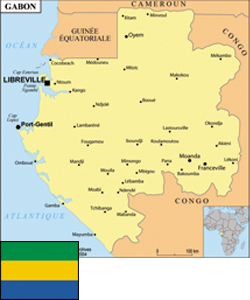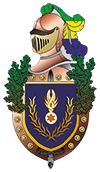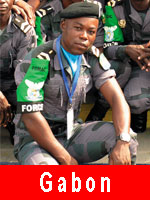 Gabonese National Gendarmerie
Gabonese National Gendarmerie
|
1960 Ministry of attachment: Ministère de la Défense nationale gabonaise Workforce: 5 700 General manager: Général d’armée Jean ÉKOUA Address: Camp Gros Bouquet Tél.: (241) 01732036 or (241) 07884477 Website: fr-fr.facebook.com/pages/Gendarmerie-Nationale-Gabonaise/ 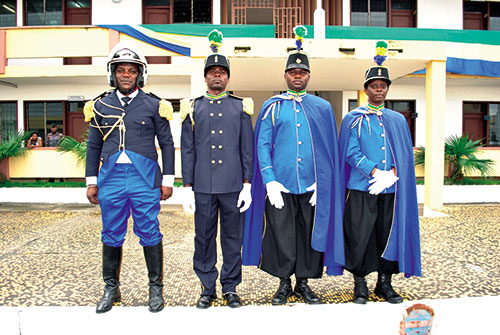
|
History
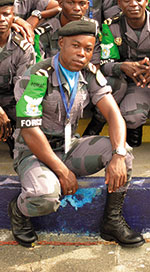 Heiress of the French colonial Gendarmerie allocated to the Gabonese territory in 1929 by the general Government of the French Equatorial Africa (FEA), the Gabonese National Gendarmerie was created by the statutory order n° 19/PM of December 30th, 1960. It is then composed of French Gendarmeries staffs put at the disposal of the Gabonese Government for the organization, the instruction and the supervision, and of Gabonese gendarmes. It accounts 648 men, from whom 265 National, and includes: 2 groups, 7 sections or companies, 28 brigades and 3 regional platoons. An intensification of the "Gabonisation" of Commands takes place from 1964. It is complete for company level commands in 1968 and intervenes at the top of the hierarchy by the appointment of Lieutenant-colonel Georges N’ KOMA in the National Gendarmerie high command with the decree n° 179 of March 4th, 1969. In 1970, the National Gendarmerie is Gabonese in all the levels of the hierarchy and is so going to assume alone its own fate.
Heiress of the French colonial Gendarmerie allocated to the Gabonese territory in 1929 by the general Government of the French Equatorial Africa (FEA), the Gabonese National Gendarmerie was created by the statutory order n° 19/PM of December 30th, 1960. It is then composed of French Gendarmeries staffs put at the disposal of the Gabonese Government for the organization, the instruction and the supervision, and of Gabonese gendarmes. It accounts 648 men, from whom 265 National, and includes: 2 groups, 7 sections or companies, 28 brigades and 3 regional platoons. An intensification of the "Gabonisation" of Commands takes place from 1964. It is complete for company level commands in 1968 and intervenes at the top of the hierarchy by the appointment of Lieutenant-colonel Georges N’ KOMA in the National Gendarmerie high command with the decree n° 179 of March 4th, 1969. In 1970, the National Gendarmerie is Gabonese in all the levels of the hierarchy and is so going to assume alone its own fate.
The Gabonese National Gendarmerie takes very quickly the necessary measures for the training of its staffs. So, it ensures from September 1962 the entire training of the auxiliary gendarmes by the creation of the auxiliary gendarmes Instruction Centre auxiliary gendarmes in Port-Gentil. In 1963, it trains its first "official gendarmes empowered to make arrests gendarmes ("Officier de Police Judiciaire" or OPJ in French) and sends to 1964 his first officer to the Officer school ("Ecole des Officiers de la Gendarmerie Nationale" or EOGN in French) of Melun in France.
It will amplify its training capacities from 1975 with the opening, to Owendo, of the Gendarmerie national school and the grouping of instruction of Owendo. It will not hesitate to recycle all staffs, during internships or training courses of a few months, from November 1979. The organization of the Gendarmerie will evolve gradually to answer the functional needs. The decree n° 130/PR of February 29th, 1968 establishes a High command, several schools of Gendarmerie, some territorial Gendarmerie and anti-riot police units (the Gendarmerie counts that time 1 023 men). Inspired by the French Gendarmerie, the Gabonese Gendarmerie knew how to become emancipated and show itself avant-gardist. Indeed, she welcomes from 1973 its first feminine recruits in the body of the feminine assistants of the gendarmerie. In 1974, the first promotion 5 better leave for France in order to receive a complete officer’s training there; they return in 1975 and are promoted to second lieutenant’s rank. Other decisions follow in order to create in particular in 1975 the national school of Gendarmerie, in 1977 the Researches General Direction, in 1979 the grouping of intervention of the National Gendarmerie Intervention Group (NGIG), in 1983 the post of general inspector of the Gendarmerie and the legions ("Légion" in French) of gendarmes. The Gendarmerie pursues, even today, its transformation because it created in 2012 the corps of mobile gendarmes, the national parks units and the military police. Its organization is governed by several decrees among which those of April 27th, 1982 and of January 14th, 1983, then that n° 195/PR/MDN of May 22nd, 2012.
Organization
Integral part of the forces of defence and security, the Gabonese National Gendarmerie has its organization fixed by the article 5 of the decree n° 195/PR/MDN of May 22nd, 2012.
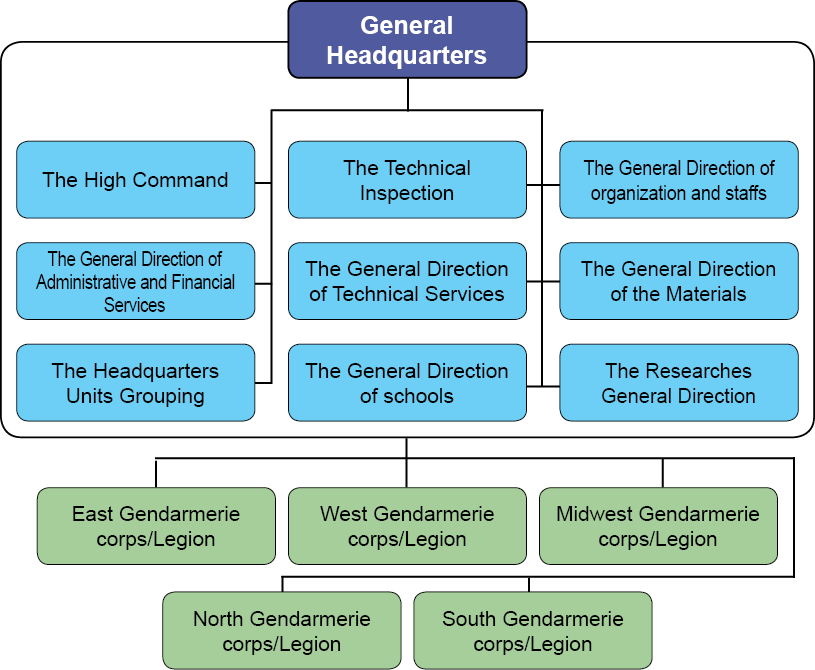
Central Organization
• The High Command.
• The Technical Inspection.
• The General Direction of organization and staffs (GDOS).
• The General Direction of Administrative and Financial Services (GDAFS).
• The General Direction of Technical Services (GDTS).
• The General Direction of the Materials (GDMAT).
• The Headquarters Units Grouping.
• The General Direction of schools.
• The Researches General Direction. In charge to look for, to exploit and to transmit intelligence within the framework of the State homeland and external security, as well as to carry out investigations, the Researches General Direction is placed for employment under the president of the Republic’s authority. The Researches Director-General has in particular under his orders the direction of the file, the external relations direction (Affairs involving the national or foreign diplomatic representations), the direction (management) of the technical and scientific police direction, and the direction of investigations with its provincial antennas.
Territorial organization
• 5 gendarmerie departmental corps/legion competent on one or several provinces.
• 9 squads ("Groupement" in French) of departmental Gendarmes (one by province).
• Territorial Companies.
• Territorial Brigades.
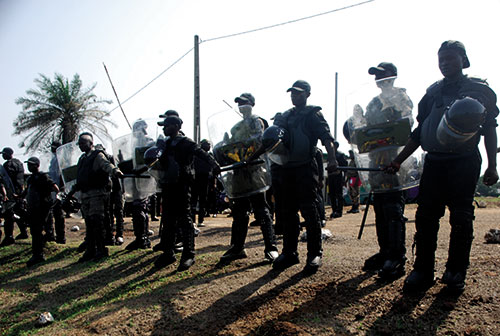
Specialized Training
• The Gendarmerie "anti-riot police" is articulated in legions, groupings, squadrons and platoons. The mobile gendarmerie legion implanted in Libreville has the particularity to have the quick response grouping possessing an armoured mixed squadron, the National Gendarmerie Intervention and Security grouping (NGISG), the Security and Honours grouping, and of the military police grouping.
• The nautical units Grouping with nautical brigades.
• The Air Transport grouping with air transports brigades.
• The Motorcycle Brigades.
In order to face the importance elephants’ slaughter with regard to the ivory trafficking and to any kind of criminal acts undermining and striking a blow at the biodiversity of the Gabon, the Gendarmerie has established national parks units (3 companies and 13 brigades) in order to strengthen the action of the agents allocated to the surveillance of these parks.
Missions
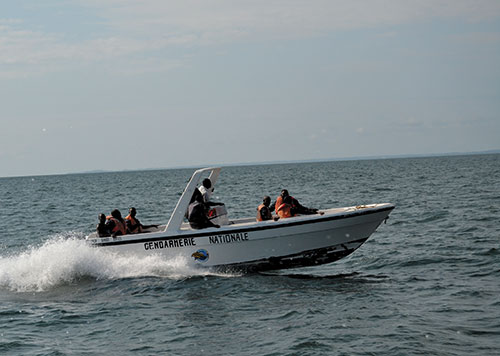
The Gendarmerie organization decree n° 195/PR/MDN of May 22nd, 2012 specifies in its article 4 the main missions of the gendarmerie:
• ensuring the integrity of the national territory;
• watching the public security;
• protecting the life of the populations and the environment;
• ensuring the preservation and restoring of the order, the execution of the laws and the regulations;
• ensuring the Criminal Investigation, administrative and military direct action;
• contributing to the respect for the Gabon foreign commitments;
• defending the vital interests of the Nation.
Staff
 The Gabonese National Gendarmerie counts today, after a strengthening of its recruitment over 3 years -2010 to 2012-, the number of 6500 servicemen distributed as follows:
The Gabonese National Gendarmerie counts today, after a strengthening of its recruitment over 3 years -2010 to 2012-, the number of 6500 servicemen distributed as follows:
• 6% of officers and 94% of non-commissioned officers;
• 77% of men and 23% of women;
• 80% allocated in units and 20% on training (officers and non-commissioned officers).
To be admitted in Gendarmerie, the candidates must:
• be of Gabonese nationality;
• be 18-year-old at least and of 26 years in most, and holders of a university or equivalent degree for the officer’s direct recruitment candidates;
• be 18-year-old at least and of 25 years in most, and holders of the High School Diploma or the ‘General Certificate Secondary education’ (GCSE) or equivalent for non-commissioned officer’s recruitment candidates;
• have satisfied to the tests of admission (Entrance examination and end of training examination);
• be recognized physically fit by an army medical officer.
Training institutions
The non-commissioned officers’ and the officers’ initial training is provided by the Gabonese Gendarmerie national School in Owendo. The pupils’ gendarmes are welcomed to the Owendo grouping of instruction. Some officers are sent to attend internships/training courses in foreign countries, as in the "Ecole des Officiers de Gendarmerie Nationale" (EOGN) of Melun (France) or in the Meknes Royal Academy (Morocco). The Gabon National Gendarmerie School welcomes pupil’s gendarmes of the other African countries within it.
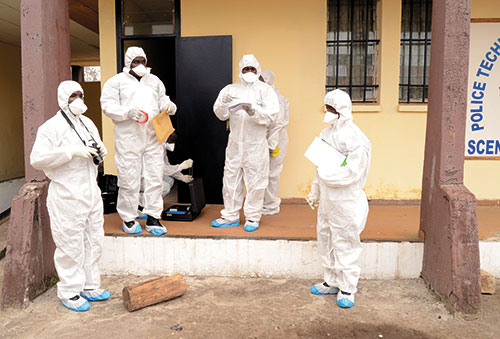
The continuing education leans on the structures of the Gendarmerie national school (Staff college diploma, official empowered to make arrests/Criminal police officer, Arm-Certificate ("Brevet d’Arme" in French), training course/Internship for future brigade commanders, training course/Internship for the future company commanders), on temporary reinforcement missions given by the Defence & Security Cooperation Direction (DSCD) (motorcyclists’ recycling, technical and forensic Police, maintenance of law and order, environmental protection, fight against the illegal work, transmissions), on the national schools with regional vocation, as well as on foreign schools (mainly in France and Morocco).
Main equipment
• Armament: weapons in service within the gendarmerie are of French and Chinese manufacturing, and are constituted:
- of handguns: automatic pistols (PA MAC, PA TOKAREV, revolvers Smith and Wesson),
- of weapons of shoulders: submachine guns (PM MAKAROV, PM Kalashnikov), pump-action shotguns, other rifles (MAS 36, KALASHNIKOV, FAMAS, FAL CAL, etc.),
- of armament for the maintenance of law and order missions: grenade launchers, teargas grenades,
- of light and heavy collective weapons: machine guns and heavy machine guns,
- of light antitank weapons: LRAC of 40 and 89 mm,
- of guns with curved trajectory fire: 60 and 81 mm mortars.
• Vehicles: the Gendarmerie has heavy and light vehicles, and also motorcycles. The motor vehicle pool constituting the gendarmerie car fleet is almost entirely constituted by cross-country vehicles to be able to move in any place of the territory.
- Light vehicles constitute a little more than 60% of motor vehicles in order to equip the territorial units and the command levels (Essentially with Mercedes mark and Asian countries - Toyota, Mitsubishi, Mazda, Nissan).
- Approximately 30% of motor vehicles (Mercedes and Iveco) are dedicated to the troop transportation, the capacity of loading varying from value of a group with more than a platoon. The vehicles of big capacity can be also used for the equipment transportation.
- The mobile Gendarmerie/anti-riot police has armoured vehicles adapted to the order preservation and restoring operations (Maverick ISV 4X4).
- The other vehicles equip technical services (tanker, workshop van, towing vehicle, truck, etc.).
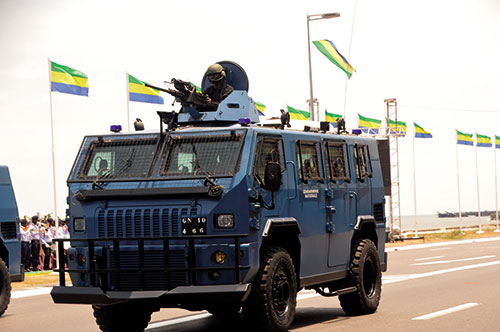
• Aerial means: the Gendarmerie doesn’t have it any more since it put back its 2 helicopters and its crews in the Army light aviation by decree n° 929/PR/MDN of July 15th, 2011, within the framework of the mutualisation of the Gabon defence forces means.
• Nautical means: The coastguards and nautical units dispose of several speedboats equipped with 90 horses and with 200 horses’ engines, with Zodiac with 200 horses’ engines and with dugouts equipped with 25 horses’ engines.
Cooperation
Within the framework of the Defence and Security cooperation missions, the Gabonese Republic Ministry of Defence and the of the French Republic Ministry of Foreign and European Affairs signed, on December 28th, 2012, two agreements for the benefit of the National Gendarmerie, the first one concerning an assistance in the form of a council with the commander-in-chief, the second one dealing with the training direction in the Gendarmerie schools.
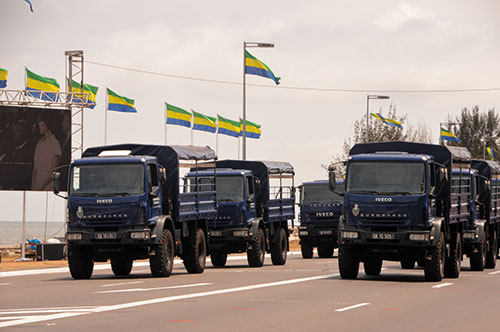
© The iconography was provided by the concerned gendarmeries

